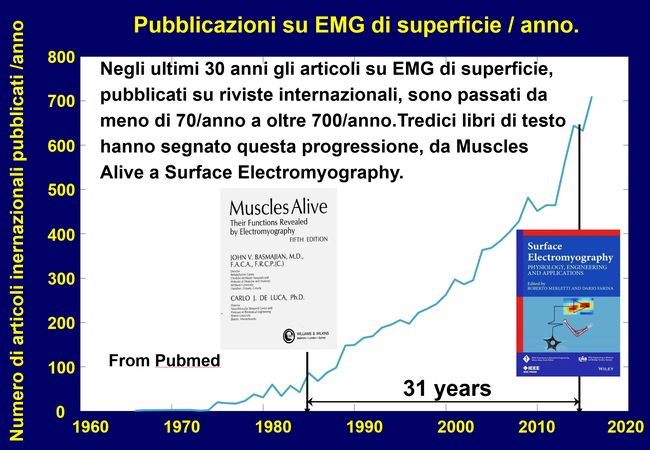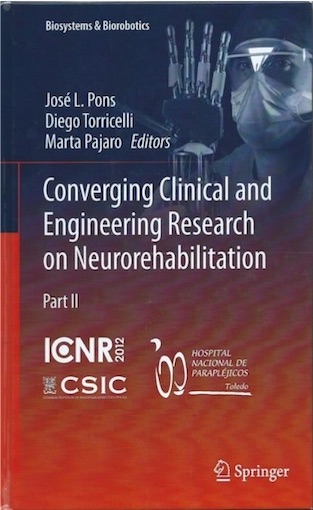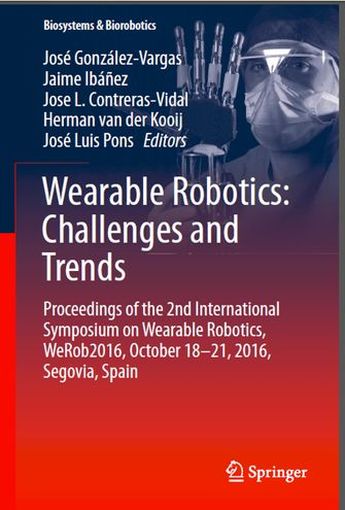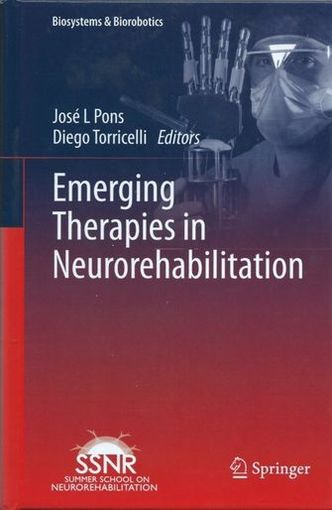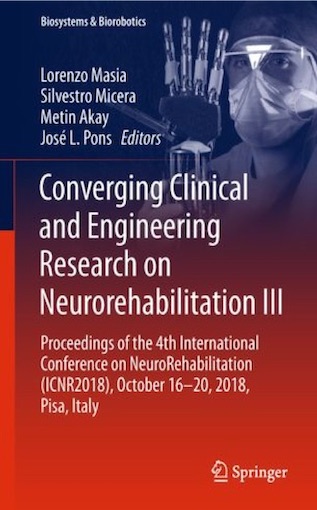Sulla elettromiografia di superficie (sEMG) esiste una amplissima letteratura scientifica consistente in testi (circa 30), capitoli in libri su altri temi, “review papers” (circa 200), contributi a enciclopedie scientifiche (oltre 20), e articoli scientifici (circa 7000, con un tasso di crescita di 700/anno) oltre a materiale reso disponibile on-line dai produttori di apparecchiature per sEMG (Delsys, Noraxon, Thought Technology, tra gli altri). Uno dei settori di applicazione della sEMG è la chinesiologia. Di questo specifico settore si occupa il “Journal of Electromyography and Kinesiology (JEK)”.
La tipologia dei testi spazia da quelli con contenuti molto elementary a quelli dedicati a tecniche avanzate di elaborazione del segnale. Alcuni testi sono dedicati ai principianti, altri agli esperti del settore. Il contenuto di numerosi testi è liberamente scaricabile dalla rete.
E’ in corso uno sforzo di ricerca continuo per estrarre dal segnale sEMG la massima quantità di informazione in esso contenuta e relativa al muscolo, al sistema nervoso periferico e centrale, alle loro patologie e alle strategie di controllo motorio.
Il materiale disponibile è fondamentale per lo studio delle scienze motorie , della neurofisiologia e della neuroriabilitazione. Esso predice la rapida evoluzione che queste scienze stanno avendo e il forte condizionamento che ne deriverà nei confronti dei professionisti di domani, studenti di oggi.
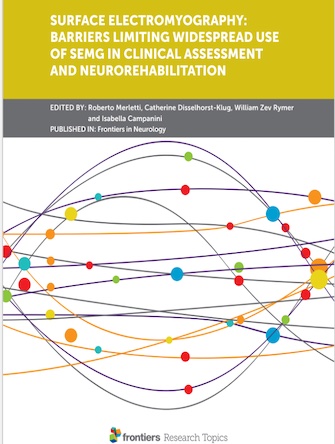
Open Access E-Book
|
Indice
- Editorial
- General papers: 2 articles
- Clinical applications and experiences: 7 articles
- Surveys of clinical operators: 2 articles
- Teaching and communications barriers: 2 articles
- Occupational medicine: 2 articles
- Exercise, sport physiology and kinesiology: 2 articles
Editorial team
R Merletti, I Campanini, W Z Rymer, C Disselhorst-Klug
Autori e revisori
- 18 lavori di 80 autori provenienti da sette paesi:
Cile, Germania, Croazia, Francia, Irlanda, Italia, USA.
- 33 ingegneri
- 16 medici
- 18 terapisti occupazionali e fisioterapisti
- 13 chinesiologi
- 40 revisori da vari paesi
|
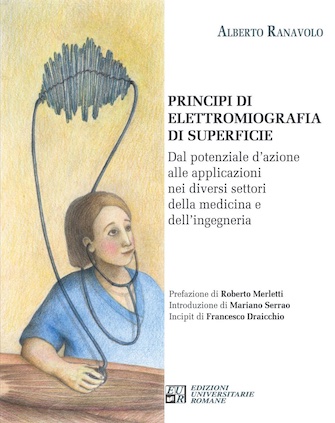
190 pagine, primo manuale in lingua italiana
|
Indice
Prefazione (Roberto Merletti)
Introduzione (Mariano Serrao)
Incipit (Francesco Draicchio)
Capitolo 1
Dalla genesi del potenziale d’azione alla contrazione muscolare
Capitolo 2
Il segnale elettromiografico di superficie,tecniche di prelievo e di elaborazione
Capitolo 3
Indici e metodi matematici e statisticinel dominio del tempo e della frequenzaCapitolo 4Alcune applicazioni della EMGs
Edizioni Universitarie Romane, 2021
|
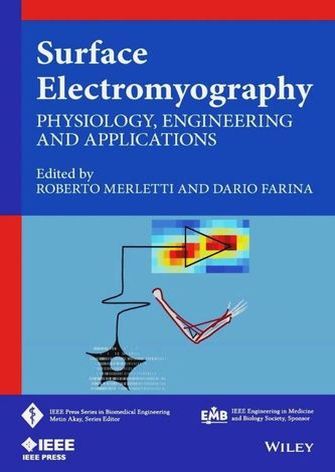
IEEE Press, J. Wiley, 2016
|
Indice
- PHYSIOLOGY OF MUSCLE ACTIVATION AND FORCE GENERATION R. Enoka, J Duchateau
- BIOPHYSICS OF THE GENERATION OF EMG SIGNALS AND FORCE D. Stegeman, D. Farina R. Merletti
- DETECTION AND CONDITIONING OF THE SURFACE EMG SIGNAL A. Botter, U. Barone, R.Merletti
- SINGLE CHANNEL TECHNIQUES FOR INFORMATION EXTRACTION FROM THE SURFACE EMG SIGNAL E Clancy, F. Negro,
D. Farina
- TECHNIQUES FOR INFORMATION EXTRACTION FROM THE SURFACE EMG SIGNAL: HIGH DENSITY SURFACE EMG R.
Merletti, T. Vieira, D. Farina
- MUSCLE COORDINATION, MOTOR SYNERGIES AND PRIMITIVES FROM SURFACE EMG F.Lacquaniti, Y.Ivanenko, F.
d'Avella
- SURFACE EMG DECOMPOSITION A. Holobar, D. Zazula
- EMG MODELING AND SIMULATION M. Lowery
- EMG-DRIVEN MODELING FOR SIMULATING THE HUMAN MUSCULOSKELETAL SYSTEM M. Sartori, D. Lloyd, T. Besier,
J. Fernabdez, D. Farina,
- MYOELECTRIC MANIFESTATIONS OF MUSCLE FATIGUE IN VOLUNTARY AND ELECTRICALLY ELICITED CONTRACTIONS R.
Merletti B. Afsharipour, J. Dideriksen, D. Farina
- EMG OF ELECTRICALLY STIMULATED MUSCLES A. Botter, R. Merletti
- SURFACE EMG APPLICATIONS IN NEUROPHYSIOLOGY J. Duchateau , S. Baudry, M. Minetto
- APPLICATIONS IN ERGONOMICS M. Gazzoni, B. Afsharipour, R. Merletti
- APPLICATIONS IN PROCTOLOGY AND OBSTETRICS R. Merletti
- EMG IN POSTURE ANALYSIS T. Vieira, D. Farina I. Loram
- EMG IN MOVEMENT AND GAIT ANALYSIS A. Merlo, I. Campanini
- APPLICATIONS IN PHYSICAL TERAPY D. Falla
- SURFACE EMG IN BIOFEEDBACK A. Gallina, M. Gazzoni, D. Falla, R. Merletti
- EMG IN EXERCISE PHYSIOLOGY AND SPORTS A. Rainoldi, T. Moritani, G. Boccia
- SURFACE EMG FOR MAN-MACHINE INTERFACING IN REHABILITATION TECHNOLOGIES D. Farina, M. Sartori
|
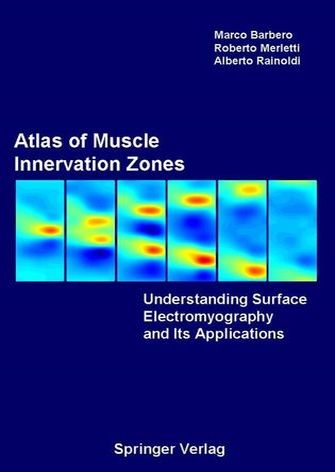
In collaborazione con il Dept. of Health Sciences, Univ. of Applied Sciences and Arts of
Southern Switzerland e la School of Exercise and Sport Sciences, Univ. of Torino, Italy.
|
Pubblicazione orientata ai fisioterapisti.
Prefazione di Gwendolin Jull.
Part I: Understanding surface EMG.
- Introduction and applications of surface EMG
- Basic concepts concerning fields and potential distributions of stationary and moving point sources.
- Generation, propagation and extinction of single fiber and motor unit action potentials
- EMG imaging: geometry and anatomy of the electrode-muscle system
- Features of the single channel sEMG signal
- Features of the two-dimensional sEMG signal: EMG feature imaging
- Applications of surface EMG in dynamic conditions, ergonomics sports and obstetrics
Part II: Atlas of muscle innervation zones
- Trunk, 14 muscles
- Upper limb, 16 muscles
- Lower limb, 13 muscles
|
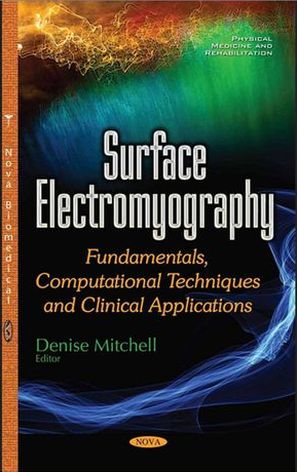
Nova Science Publishers Inc., 2016
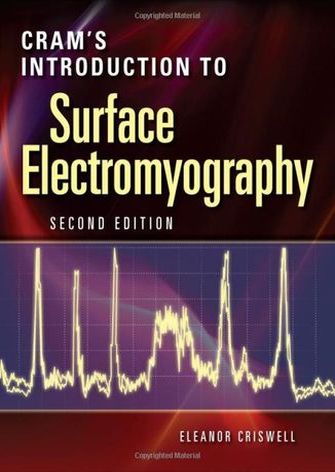
Jones & Bartlett Learning, 2010
|
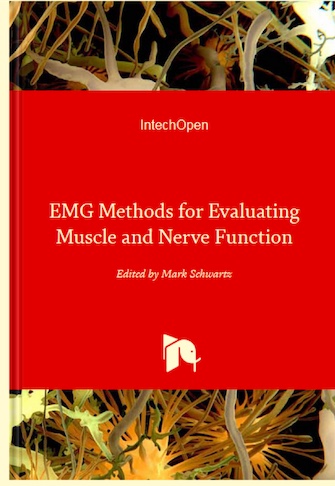
Edited by Mark Schwartz Pub.: January 2012
DOI: 10.5772/1465 ISBN: 978-953-307-793-2
https://www.intechopen.com/books/
|
Indice
- A Critical Review and Proposed Improvement in the Assessment of Muscle Interactions Using Surface EMG
- Location of Electrodes in Surface EMG
- The Relationship Between EMG and Muscle Force
- Electromyography in Myofascial Syndrome
- Clinical Implications of Muscle-Tendon & -Force Interplay
- Nonlinear Analysis for Evaluation of Age-Related Muscle Performance Using sEMG
- The Usefulness of Wavelet Transform to Reduce Noise in the SEMG Signal
- Nonlinear Analysis of Surface Electromyography
- sEMG Techniques to Detect and Predict Localised Muscle Fatigue
- Clinical Application of Silent Period for the Evaluation of Neuro-Muscular Function in the Field of the Sports Medicine and Rehabilitation
- Middle and Long Latency Auditory Evoked Potentials and Their Usage in Fibromyalgia and Schizophrenia
- Non-Invasive Diagnosis of Neuromuscular Disorders by High-Spatial-Resol.-EMG
- EMG vs. Thermography in Severe Carpal Tunnel Syndrome
- Functional Significance of Facilitation Between the Pronator Teres and Extensor Carpi Radialis in Humans
- Visual and Brainstem Auditory Evoked Potentials in Neurology
- Extraction and Analysis of the Single Motor Unit F-Wave of the Median Nerve
- EMG and Evoked Potentials in the Operating Room During Spinal Surgery
- Combination of Transcranial Magnetic Stimulation with EMG and EEG
- Muscle Force Analysis of Human Foot Based on Wearable Sensors and EMG
- Affective Processing of Loved Familiar Faces: Contributions from EMG.
- Noninvasive Monitoring of Breathing and Swallowing Interaction
- Man to Machine, Applications in EMG
- Water Surface Electromyography
- Scanning Electromyography
- EMG PSD Measures in Orthodontic Appliances
- New Measurement Techniques of sEMG Signals in Rest
- Position for Application in the Ophthalmological Field
|
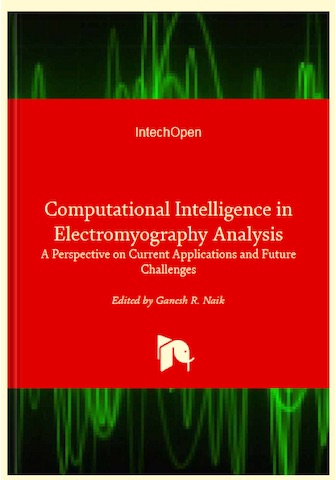
Edited by Ganesh Naik
October 2012
DOI: 10.5772/3315
ISBN: 978-953-51-0805-4
https://www.intechopen.com/books/
|
Indice
- EMG Modeling
- Modelling of Transcranial Magnetic Stimulation in One-Year Follow-Up Study of Patients with Minor Ischaemic Stroke
- Relationships Between Surface Electromyography and Strength During Isometric Ramp Contractions
- Comparison by EMG of Running Barefoot and Running Shod
- Influence of Different Strategies of Treatment Muscle Contraction and Relaxation Phases on EMG Signal Processing and Analysis During Cyclic Exercise
- Nonlinear Analysis of Surface EMG Signals
- Normalization of EMG Signals: To Normalize or Not to Normalize and What to Normalize to?
- The Usefulness of Mean and Median Frequencies in Electromyography Analysis
- Feature Extraction Methods for Studying Surface Electromyography and Kinematic Measurements in Parkinson’s Disease
- Distinction of Abnormality of Surgical Operation on the Basis of Surface EMG Signals
- EMG Decomposition and Artefact Removal
- Sphincter EMG for Diagnosing Multiple System Atrophy and Related Disorders
- Hand Sign Classification Employing Myoelectric Signals of Forearm
- Proposal of a Neuro Fuzzy System for Myoelectric Signal Analysis from Hand-Arm Segment
- Design and Control of an EMG Driven IPMC Based Artificial Muscle Finger
- Application of Surface Electromyography in the Dynamics of Human Movement
- Virtual and Augmented Reality: A New Approach to Aid Users of Myoelectric Prostheses
- Signal Acquisition Using Surface EMG and Circuit Design �Considerations for Robotic Prosthesis
|
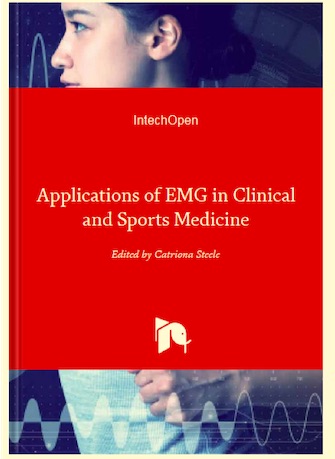
Edited by Catriona Steele
January 2012
DOI: 10.5772/2349
ISBN: 978-953-307-798-7
https://www.intechopen.com/books/
|
Indice
- Evaluating the Electromyographical Signal During Symmetrical Load Lifting
- EMG Analysis Methods on Robotic Gait Machines
- Electromyography in the Study of Muscle Reactions to Vibration Treatment
- The Role of Electromyography (EMG) in the Study of Anticipatory Postural Adjustments
- Application of Surface Electromyographic Signals to Control Exoskeleton Robots
- Trunk Muscle Activity Affects the Level of Performance in Human Body
- EMG in People with Different Heel Height Condition
- Muscle Activation Patterns During Level Walking and Stair Ambulation
- Experimentation and Structural Modeling of Stimulus-Evoked Electromyography in Muscles During Electrically-Elicited Fatigue Process
- Assessment of Low Back Muscle by Surface EMG
- EMG Analysis of a Pilates Exercise
- Electromyography Monitoring for Complete and Incomplete Transections of the Spinal Cord in Humans
- EMG Applications in Studies of Arts
- SEMG During Both Standing and Walking in m. Ulnaris lateralis of Diversely Trained Horses
- Arthroscopic Treatment of Suprascapular Nerve Neuropathy
- An Uterine EMG Activity as a Measure of Labor Progression
- The Role of Pelvic and Perineal Muscles in Reproductive and Excretory Functions
- EMG in Diagnosis of Functional Status of Pelvic Floor Muscles in Women with Urinary Incontinence
- Electromyography as a Biofeedback Tool for the Rehabilitating of Swallowing Muscle Function
|
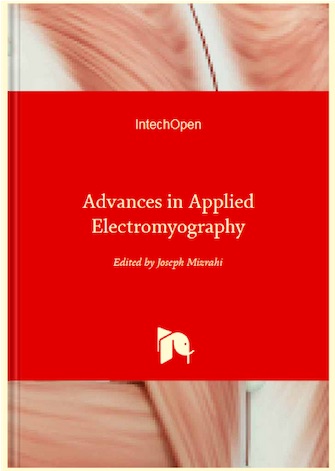
Advances in Applied Electromyography
Edited by Joseph Mizrahi,
October 2011
DOI: 10.5772/883
ISBN: 978-953-307-382-8
https://www.intechopen.com/books/
|
Indice
- The Role of EMG in Resolving Musculoskeletal Interactions in Able-Bodied and Disabled Human Individuals
- Electromyography Assessment of Muscle Recruitment Strategies During High-Intensity Exercise
- Classification of Upper Limb Motions from Around-Shoulder Muscle Activities
- Walking and Jogging: Quantification of Muscle Activity of the Lower Extremities
- EMG Signal Noise Removal Using Neural Netwoks
- Electromyography Pattern-Recognition-Based Control of Powered Multifunctional Upper-Limb Prostheses
- Pinching Effort Evaluation Based on Tendon Force Estimation
- Electromyogram of the Cibarial Pump and the Feeding Process in Hematophagous Hemiptera
- Anal Sphincter Electromyogram for Dysfunction of Lower Urinary Tract and Pelvic Floor
- Electromyography of Pelvic Floor Muscles in Rats
|
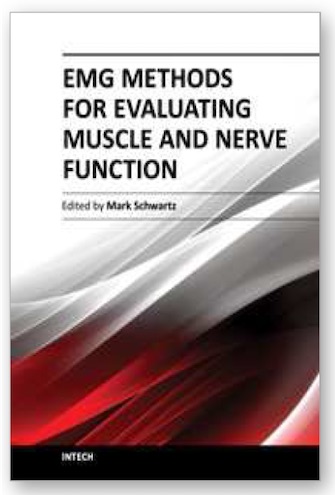
Edited by Mark Schwartz
January 2012
DOI: 10.5772/1465
ISBN: 978-953-307-793-2
https://www.intechopen.com/books/
|
Indice
- A Critical Review and Proposed Improvement �in the Assessment of Muscle Interactions Using sEMG
- Location of Electrodes in Surface EMG
- The Relationship Between Electromyography and Muscle Force
- Electromyography in Myofascial Syndrome
- Clinical Implications of Muscle-Tendon & Force Interplay
- Nonlinear Analysis for Evaluation of Age-Related Muscle Performance Using Surface Electromyography
- The Usefulness of Wavelet Transform to Reduce Noise in the SEMG Signal
- Nonlinear Analysis of Surface Electromyography
- sEMG Techniques to Detect and Predict Localised Muscle Fatigue
- Clinical Application of Silent Period for the Evaluation of Neuro-Muscular Function in the Field of the Sports Medicine and Rehabilitation
- Middle and Long Latency Auditory Evoked Potentials and Their Usage in Fibromyalgia and Schizophrenia
- Non-Invasive Diagnosis of Neuromuscular Disorders by High-Spatial-Resolution-EMG
- EMG vs. Thermography in Severe Carpal Tunnel Syndrome
- Functional Significance of Facilitation Between the Pronator Teres and Extensor Carpi Radialis in Humans: Studies with Electromyography and Electrical Neuromuscular Stimulation
- Visual and Brainstem Auditory Evoked Potentials in Neurology
- Extraction and Analysis of the Single Motor Unit F-Wave of the Median Nerve
- EMG and Evoked Potentials in the Operating Room During Spinal Surgery
- Combination of Transcranial Magnetic Stimulation with Electromyography and Electroencephalography: Application in Diagnosis of Neuropsychiatric Disorders
- Muscle Force Analysis of Human Foot Based on Wearable Sensors and EMG Method
- Affective Processing of Loved Familiar Faces: Contributions from Electromyography
- Noninvasive Monitoring of Breathing and Swallowing Interaction
- Man to Machine, Applications in Electromyography
- Water Surface Electromyography
- Scanning Electromyography
- EMG PSD Measures in Orthodontic Appliances
- New Measurement Techniques of Surface Electromyographic �Signals in Rest Position for Application in the Ophthalmological Field
|
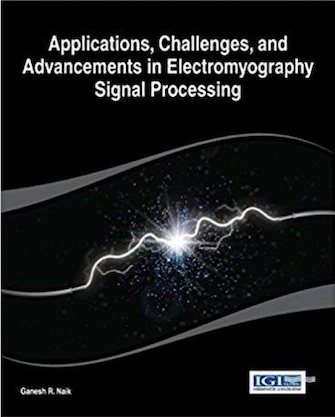
Applications, Challenges, and Advancements
In Electromyography Signal Processing
Editor. Ganesh Naik, May 2014
University of Technology Sydney
DOI: 10.4018/978-1-4666-6090-8
ISBN-13: 978-1466660908
ISBN-10: 1466660902
|
Indice
- Neural Control of Muscle
- New Advances in Single Fiber Electromyography
- Detection and Conditioning of EMG
- An Introduction to EMG Signal Processing Using MatLab and Microsoft Excel
- Modeling the Human Elbow Joint Dynamics from sEMG
- Arm Swing during Human Gait Studied by EMG of Upper Limb Muscles
- Using in Vivo Subject-Specific Musculotendon Parameters to Investigate Voluntary Movement Changes after Stroke
- Study and Interpretation of Neuromuscular Patterns in Golf
- Assessing Joint Stability from Eigenvalues Obtained from Multi-Channel EMG: a spine example
- Endurance Time Prediction using Electromyography
- EMG Activation Pattern during Voluntary Bending and Donning Safety Shoes
- Tongue Movement Estimation Based on Suprahyoid Muscle Activity
- Design of Myocontrolled Neuroprosthesis: Tricks and Pitfalls
- Design and Development of EMG Conditioning System and Hand Gesture Recognition Based on Principal Component Analysis Feature Reduction Technique
- The Relationship between Anthropometric Variables and Features of Electromyography Signal for Human–Computer Interface
|
Testi Springer su temi affini (Proc. of Int. Conf. on NeuroRehabilitation)
|
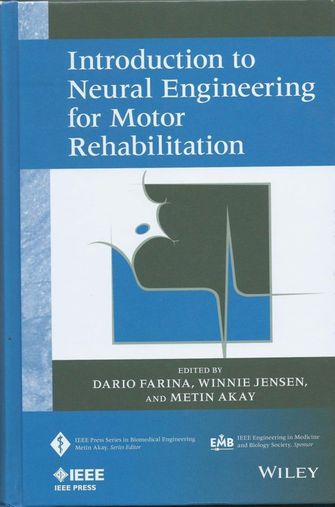
IEEE Press, J. Wiley, 2013
|
Introduzione alla neuroingegneria nella riabilitazione motoria
Part 1. Injuries of the nervous systemc (3 contributions)
Part 2. Signal detection and conditioning (Eight contributions)
Part 3. Function replacement (Prostheses and orthosis) (Six contributions)
Part 4. Function restoration (Five contributions)
Part 5. Rehabilitation through neuromodulation (Six contributions)
|
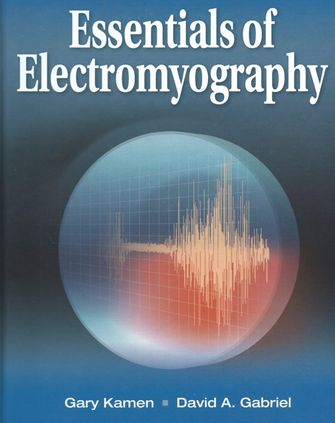
Human Kinetics, 2010
www.humankinetics.com
|
Essentials of Electromyography
Gary Kamen, David A. Gabriel
-
Chapter 1. Anatomy and Physiology of Muscle Bioelectric Signals
- Anatomical Features of Muscle
- Physiology of the Muscle Fiber
- Motor Unit Features
- Techniques for Modulating Muscular Force
- Other Physiological Influences on the Electromyogram
- For Further Reading
-
Chapter 2. Bioelectricity
- Forces in Electricity
- Essentials of Electric Circuits
- Essentials of Alternating Current
- For Further Reading
-
Chapter 3. EMG Instrumentation
- Electrodes
- Electrode Configuration
- Amplifier Characteristics
- Grounding
- Computer Interfacing
- For Further Reading
-
Chapter 4. EMG Signal Processing
- Amplitude
- Cross-Correlation Function
- Frequency
- Data Window Length
- Noise Contamination
- Basic Concepts of Digital Filtering
- For Further Reading
-
Chapter 5. EMG–Force and EMG–Fatigue Relationships
- Relationships Between Muscular Force and EMG
- EMG Analysis During Fatiguing Contractions
- Advanced EMG Issues During Fatiguing Contractions
- For Further Reading
-
Chapter 6. Other EMG Applications
- EMG and Gait
- EMG Activation Timing
- Evoked Potentials
- Ballistic Movements
- For Further Reading
- Appendix 2.1 Calculation of Electric Fields
- Appendix 2.2 Calculating the Electric Potential at a Point
- Appendix 2.3 Electric Circuits
- Appendix 2.4 Charging a Capacitor Through a Resistor
- Appendix 2.5 The Muscle Fiber as an RC Circuit
- Appendix 3.1 Muscle–Tendon End Effects
- Appendix 4.1 EMG Area and Slope Measurement
- Appendix 4.2 Cross-Correlation Function
- Appendix 4.3 Calculating Fourier Coefficients
|
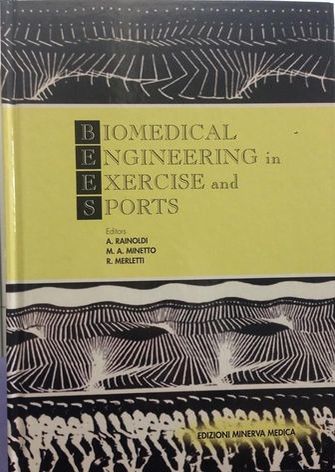
|
Edizioni Minerva Medica Torino, 2006
Editors: A. Rainoldi, M. A. Minetto, R. Merletti
Quindici contributi di 29 scienziati internazionali
-
Part 1. Skeletal muscle
Cinque contributi
-
Part 2. Biomechanics
Tre contributi
-
Part 3. Technology
Tre contributi
-
Part 4. Electrical Stimulation in Sports
Quattro contributi
|
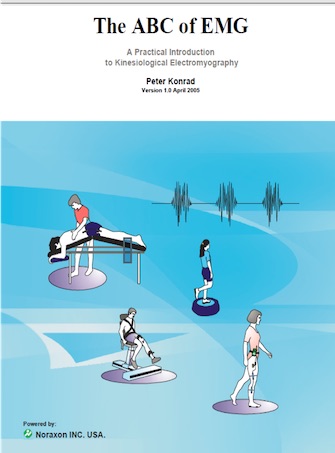
The ABC of EMG, Peter Konrad, Noraxon, 2005
|
Indice
- Technical considerations
- Myoelectric signal parameters
- New techniques
|
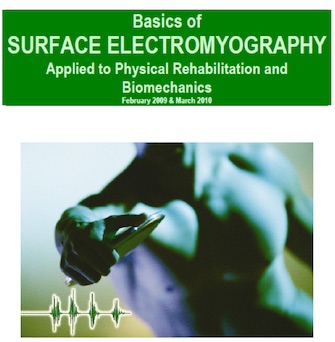
Thought Technology Ltd. 2009-2010
|
Indice
- Skeletal muscle properties
- Detection of sEMG signals
- The sEMG signal
- Examples of use
|
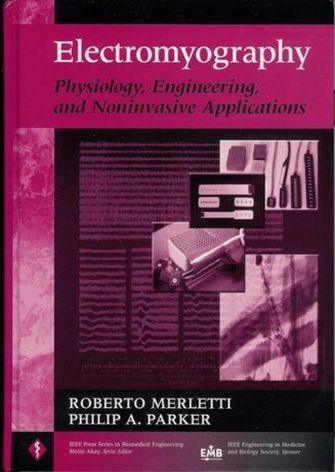
IEEE Press, J. Wiley, 2004
|
Table of contents
- BASIC PHYSIOLOGY AND BIOPHYSICS OF EMG SIGNAL GENERATION T. Moritani, D. Stegeman, R. Merletti
- NEEDLE AND WIRE DETECTION TECHNIQUES J. V. Trontelj, J. Jabre, M. Mihelin
- DECOMPOSITION OF INTRAMUSCULAR EMG SIGNALS D. W. Stashuk, D. Farina, K. Søgaard
- BIOPHYSICS OF THE GENERATION OF EMG SIGNALS D. Farina, R. Merletti, D. F. Stegeman
- DETECTION AND CONDITIONING OF THE SURFACE EMG SIGNAL R. Merletti, H. Hermens
- SINGLE-CHANNEL TECHNIQUES FOR INFORMATION EXTRACTION FROM THE SURFACE EMG SIGNAL E. A. Clancy, D.
Farina, G. Filligoi
- MULTI-CHANNEL TECHNIQUES FOR INFORMATION EXTRACTION FROM THE SURFACE EMG D. Farina, R. Merletti, C.
Disselhorst-Klug
- EMG MODELING AND SIMULATION D. F. Stegeman, R. Merletti, H. J. Hermens
- MYOELECTRIC MANIFESTATIONS OF MUSCLE FATIGUE R. Merletti, A. Rainoldi, D. Farina
- ADVANCED SIGNAL PROCESSING TECHNIQUES D. Zazula, S. Karlsson, C. Doncarli
- SURFACE MECHANOMYOGRAM C. Orizio
- SURFACE EMG APPLICATIONS IN NEUROLOGY M. J. Zwarts, D. F. Stegeman, J. G. van Dijk
- APPLICATIONS IN ERGONOMICS G. M. Hägg, B. Melin, R. Kadefors
- APPLICATIONS IN EXERCISE PHYSIOLOGY F. Felici
- APPLICATIONS IN MOVEMENT AND GAIT ANALYSIS C. Frigo, R. Shiavi
- APPLICATIONS IN REHABILITATION MEDICINE AND RELATED FIELDS A. Rainoldi, R. Casale, P. Hodges, G.
Jull
- BIOFEEDBACK APPLICATIONS J. R. Cram
- CONTROL OF POWERED UPPER LIMB PROSTHESES P. A. Parker, K. B. Englehart, B. S. Hudgins
|
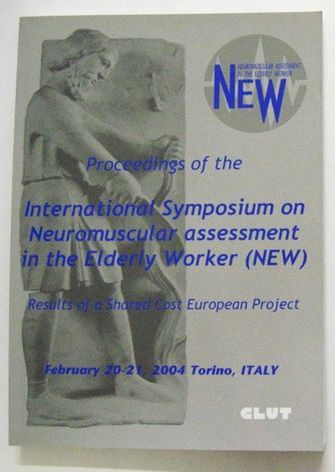
|
Atti del simposio conclusivo del progetto europeo “Neuromuscular Assessment in the Elderly Worker (NEW)”, 2004.
Section 1: Epidemiology
Section 2: Information extraction from EMG and MMG.
Section 3: Advanced techniques for neuromuscular clinical assessment.
Section 4: Applications in biofeed-back, rehabilitation and sport medicine.
Disponibile presso il LISIN, Dip. di Elettronica, Politecnico di Torino
|
Atti del simposio conclusivo del progetto europeo “Prevention of muscle disorders in the operation of
computer input devices (PROCID)”, 1999 and 2001.
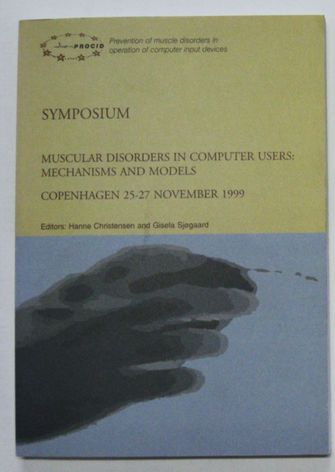
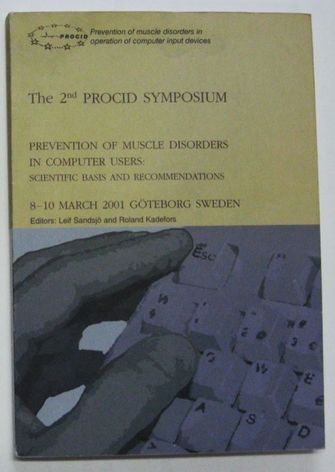
Disponibile presso il LISIN, Dip. di Elettronica, Politecnico di Torino
|
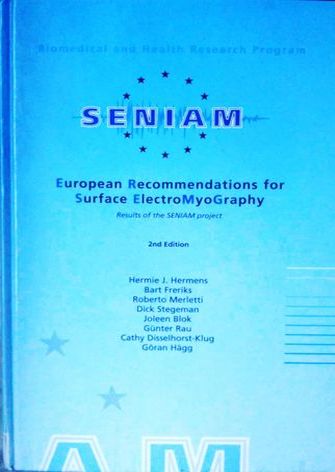
Roessing Research and Development, Enschede, The Netherlands, 1999. www.seniam.org
|
Indice
- The Seniam Project B. Freriks, H Hermens
- Recommendations for sensors and sensor placement procedures for surface electromyography B. Freriks,
H Hermens, C. Disselhorst-Klug, G. Rau
- EU Recommendations for signal processing methods for surface EMG R. Merletti, D. Farina, H. Hermens,
B. Freriks, J Harlaar
- The SENIAM models for surface EMG J. Blok, D. Stegeman, B. Freriks, H Hermens
- Guidelines for reporting surface EMG data R. Merletti, W. Wallinga, H. Hermens, B. Freriks
- The SENIAM CD-rom B. Freriks
- Overview of SENIAM papers and publications
Il libro riporta i risultati della European Concerted Action “Surface Electromyography for Non Invasive
Assessment of Muscles (SENIAM)”. Il libro è stato una guida di riferimento per molti anni. Sia il libro
che le “Raccomandazioni” sono state aggiornate o modificate da molte pubblicazioni recenti. Il libro è
anche stato tradotto in italiano. Vedere anche www.seniam.org.
|
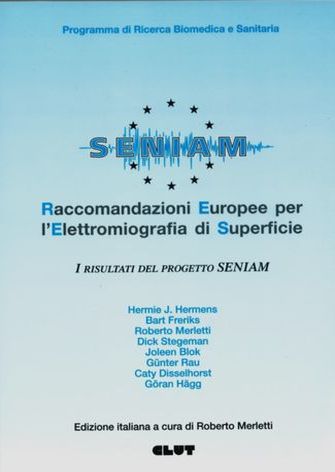
|
Traduzione italiana del “European Recommendations for Surface Electromyography”, Edizioni Coop. Libraria
Universitaria. Torino (CLUT), Italy, 2000.
|
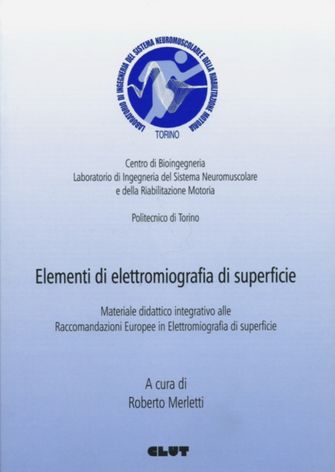
|
Libro di accompagnamento curato da R. Merletti. Contributors: R. Casale, D. Farina, M. Gazzoni, R.
Merletti, A. Merlo, M. Nazzaro, P. Parker, A. Rainoldi, M.P. Schieroni, Edizioni Coop. Libraria
Universitaria. Torino (CLUT), Italy, 2000.
|
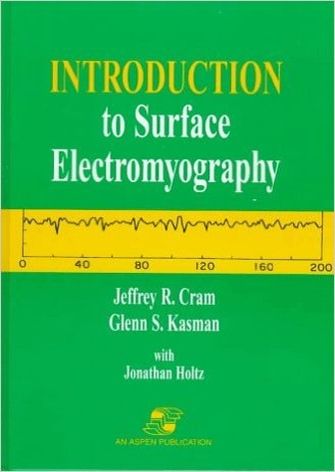
Aspen Publishers, 1998
ISBN 0834207516, 9780834207516
|
Indice
- Chapter 1 Introduction
- Chapter 2 Anatomy and Physiology
- Chapter 3 Instrumentation
|
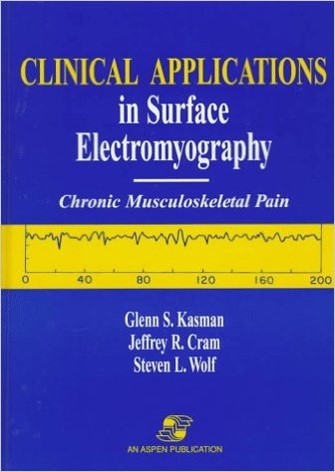
Aspen Publishers, 1998
ISBN 0834207524, 9780834207523
|
Indice
- Part 1. The basics of surface electromyography
- Part 2. Surface electromyography: past, present and future
- Part 3. Atlas of electrode placements
|
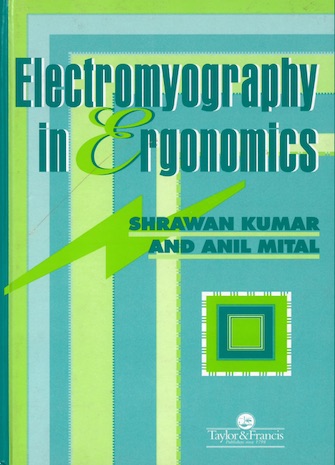
Taylor and Francis, 1996
ISBN 0 7484 0130 X
|
Indice
- Electromyography in ergonomics
- Physiological basis and concepts of electromyography
- Noise and artefacts
- EMG interpretation
- Muscle energetics and electromyography
- EMG alterations at sustained contractions with special emphasis on applications in ergonomics
- Electromyography of upper extremity muscles and ergonomic applications
- EMG of neck and shoulder muscles: the relationship between muscle activity and muscle pain in occupational settings
- Surface electromyographic assessment of low back pain
- Applications of EMG in ergonomics: a clinical perspective
|
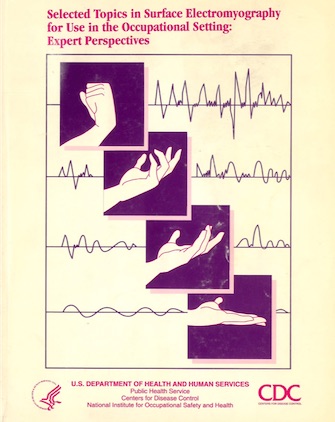
National Institute of Occupational
Safety and Health
USA, 1992
|
Indice
- Overview of electromyography in ergonomics
- Anatomic and physiologic basis for sEMG
- Recording techniques
- Instrumentation
- Data analysis and applications: interpretation of sEMG
- Functional muscle: effect on electromyographic output
- Electromyography of upper extremity muscles and ergonomic applications
- EMG of neck and shoulder muscles: the relationship between muscle activity and muscle pain in occupational settings
- Surface electromyographic assessment of low back pain
- Applications of EMG in ergonomics
|
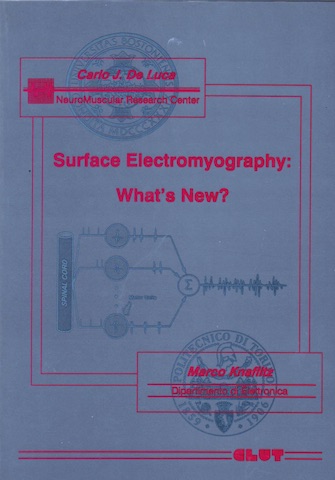
Surface Electromyography: what’s new? Carlo De Luca, Marco Knaflitz
Edizioni CLUT, Torino, Italy, 1992, 67 pages
|
Indice
- Technical considerations
- Myoelectric signal parameters
- New techniques
Questa monografia illustra lo stato dell’arte al 1992 ed è rivolta agli ingegneri della riabilitazione e ai “life scientists” con conoscenze di base di elettronica e di elaborazione dei segnali.
|
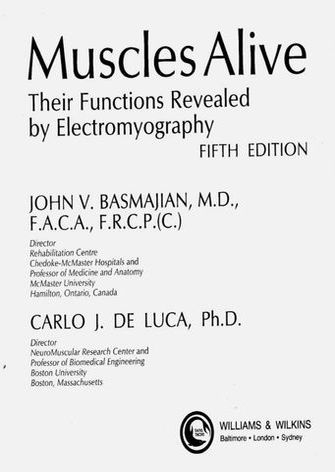
Fifth edition, 1985
|
“Muscle Alive” e’ stato il primo testo fondamentale di elettromiografia per fisioterapisti e
chinesiologi. La prima edizione, di cui fu autore il Prof. J. Basmajian (MD) fu pubblicata nel 1962.
La quinta edizione, del Prof. J. Basmajian (MD) e del Prof C. J. De Luca (PhD in Anatomia and Ingegneria
Elettronica) fu pubblicata nel 1985.
J. Basmajian e C. J. De Luca sono stati I pionieri del settore.
|
De Luca C. J. Electromyography, Encyclopedia of Medical Devices and Instrumentation, J. G Webster editr, J Wiley Publ., 98-109, 2006
Carlo De Luca, Boston University, Boston, Massachusetts
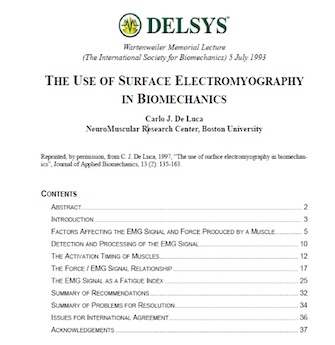
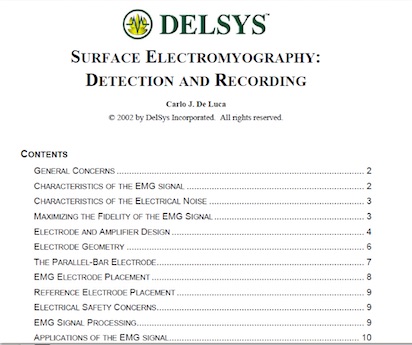
|
Capitoli su sEMG in libri su altri temi
- A New Method for Quantitative Evaluation of Neurological Disorders based on EMG signals Jongho Lee, Yasuhiro Kagamihara and Shinji Kakei Part of the book: Recent Advances in Biomedical Engineering
- A Review of EMG Techniques for Detection of Gait Disorders Rajat Emanuel Singh, Kamran Iqbal, Gannon White and Jennifer K. Holtz Part of the book: Artificial Intelligence - Applications in Medicine and Biology [Working Title]
- Quantitative Analysis of Leg Movement and EMG signal in Expert Japanese Traditional Dancer Woong Choi, Tadao Isaka, Hiroyuki Sekiguchi and Kozaburo Hachimura Part of the book: Advances in Human-Robot Interaction
- Control Systems of Bionic Limbs of the New Generation and Control Systems with EMG Signals of VR and Games and Toys Natallia Ivaniuk, Zahar Ponimash, Vladimir Karimov and Valentsin Shepanskiy Part of the book: Biofeedback
- EMG-Controlled Prosthetic Hand with Fuzzy Logic Classification Algorithm Beyda Taşar and Arif Gülten Part of the book: Modern Fuzzy Control Systems and Its Applications
- Recent Trends in EMG-Based Control Methods for Assistive Robots R. A. R. C. Gopura, D. S. V. Bandara, J. M. P. Gunasekara and T. S. S. Jayawardane Part of the book: Electrodiagnosis in New Frontiers of Clinical Research
- Evoked EMG Makes Measurement of Muscle Tone Possible by Analysis of the H/M Ratio Satoru Kai and Koji Nakabayashi Part of the book: Electrodiagnosis in New Frontiers of Clinical Research
- Age-Related Neuromuscular Adjustments Assessed by EMG Adalgiso Coscrato Cardozo, Mauro Gonçalves, Camilla Zamfolini Hallal and Nise Marques Part of the book: Electrodiagnosis in New Frontiers of Clinical Research
- Experimental and Simulated EMG Responses in the Study of the Human Spinal Cord Rinaldo André Mezzarane, Leonardo Abdala Elias, Fernando Henrique Magalhães, Vitor Martins Chaud and André Fabio Kohn Part of the book: Electrodiagnosis in New Frontiers of Clinical Research
- Overview of the Application of EMG Recording in the Diagnosis and Approach of �Neurological Disorders Yunfen Wu, María Ángeles Martínez Martínez and Pedro Orizaola Balaguer Part of the book: Electrodiagnosis in New Frontiers of Clinical Research
- Pelvic floor EMG: principles, technique and applications, Merletti R.�Ch 7 of the book Childbirth-related pelvic floor dysfunctions
- The electromyogram �Ch. 5 of the book Bioelectrical signal processing in cardiac and neurological applications
- Measurements of localized muscle fatigue in biceps brachii using objective and subjective measures, S. Kumar, T. Amell, Y. Narayan, N. Prasad� Ch, 6 of the book Muscle Strength
- Electromyography and muscle force, C.M. Sommerich, W. S. Marras �Ch. 17 of the book Muscle Strength
- Myoelectric manifestations of muscle fatigue, R. Merletti, D. Farina, A. Rainoldi�Ch. 18 of the book Muscle Strength
|
